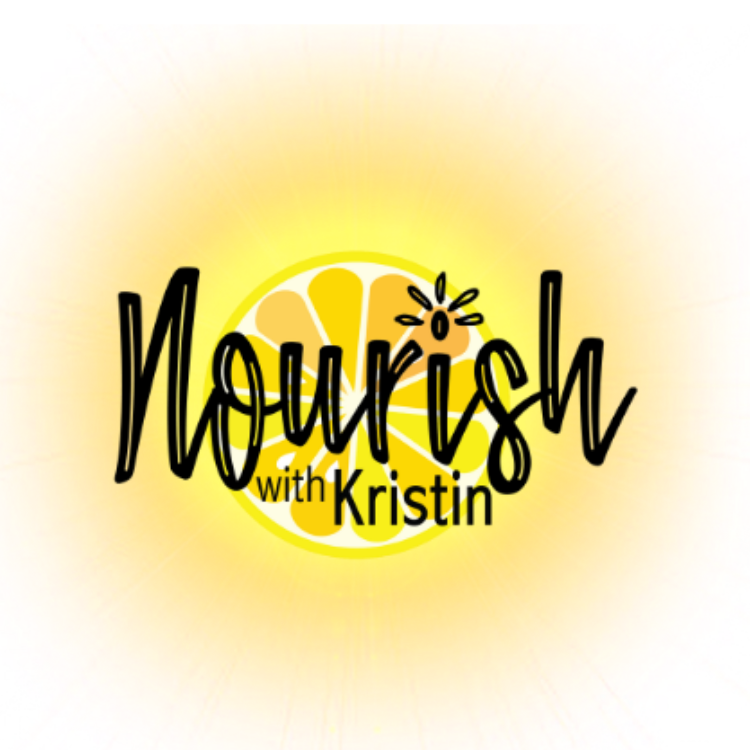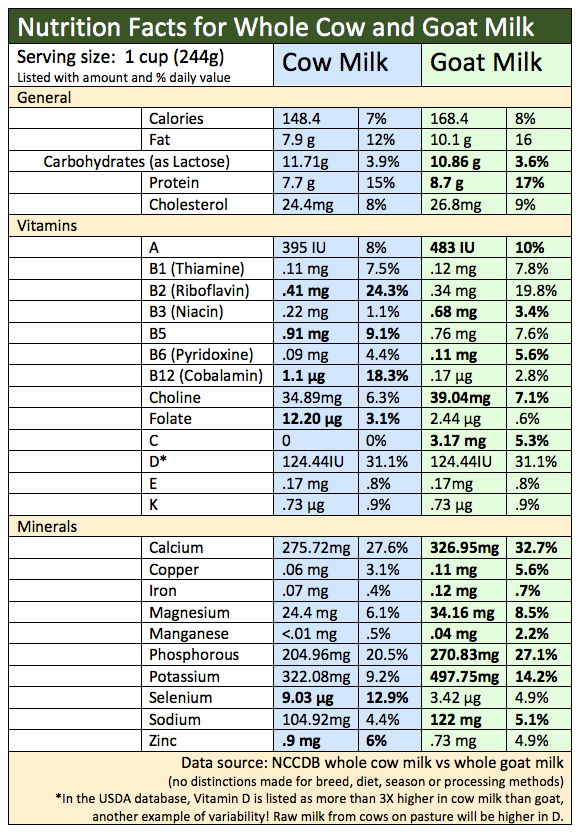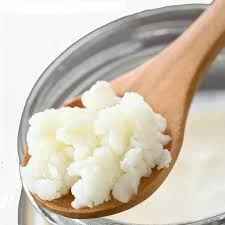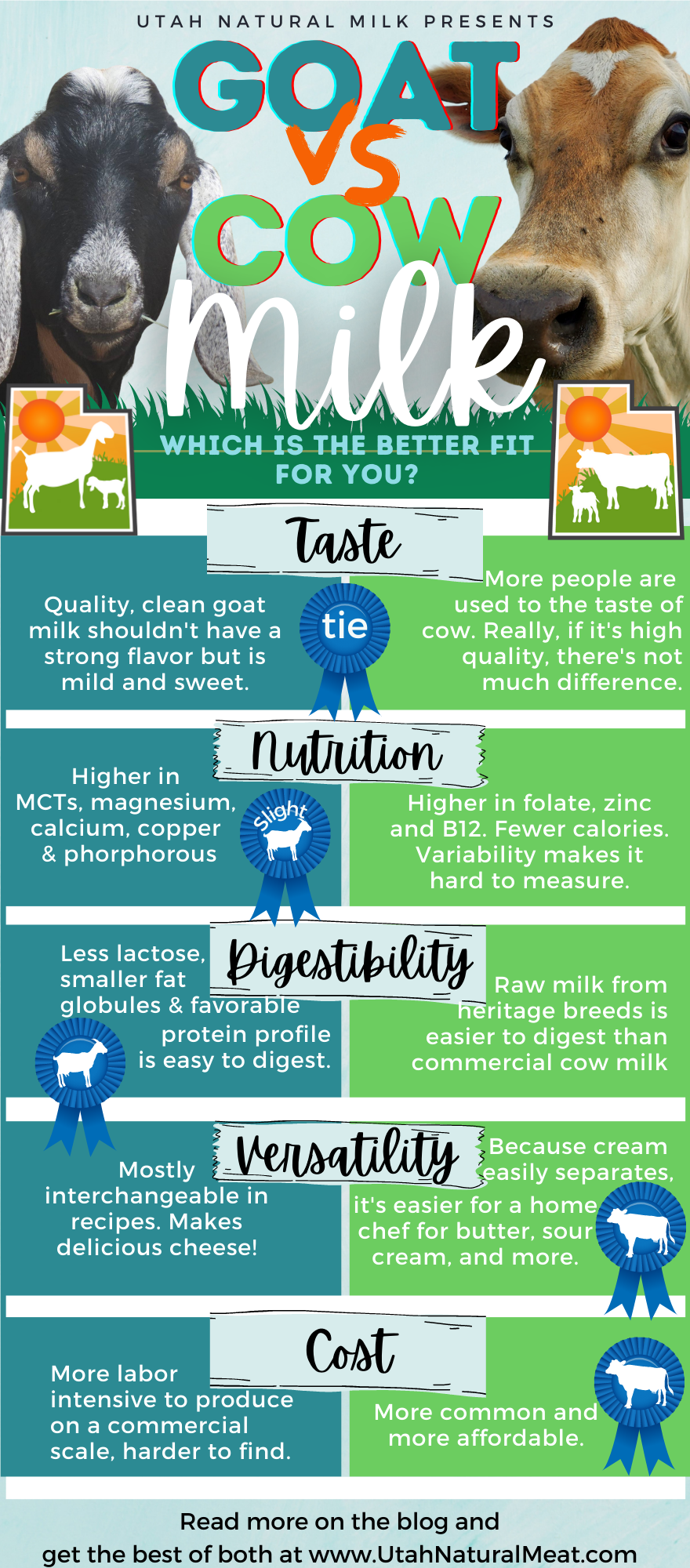Comparing Cow Milk & Goat Milk: which is the better choice for your family?
I get asked all the time which is better for you, cow milk or goat milk? The answer is…it depends! Both are nutritional powerhouses when consumed in their raw, whole state. Let’s dive in and look at taste, nutrition, digestibility, cost and more to find out which milk is the best choice for you and your family! Scroll to the bottom for a quick infographic if you want answers as a glance.
What does Goat Milk Taste Like?
This is a hard one to answer. It depends on the breed, the diet and the cleanliness of the animals. If the milk is fresh and handled properly, there isn’t a huge difference between the taste of cow milk and goat. In fact, I’ve been able to switch milks on people and not have them notice. My favorite is serving fresh milk to people who swear goat milk is the worst only to find out they just drained a glass! If the thought of goat milk conjures words like pungent, strong or even nasty…odds are you had bad or mishandled goat milk. It should be mild, creamy and even slightly sweet. Goat milk is described by some as tangier than cow, but again, this should be slight.
There is also an indescribable quality. People will describe goat milk as “goaty.” Again, this should be a mild, if detectable sensation. But, if you become accustomed to drinking goat milk and suddenly pour a glass of cow milk, you may be surprised to find it tastes “cowy.” There’s no other way to describe this but to experience it.
On a personal note, I’ve raised dairy goats myself and I’ve tasted goat milk from different farms, off different shelves. There is a wide range of flavors! Utah Natural Milk has the best goat milk I’ve ever tasted! It is clean and sweet and fresh. I am a big fan!
Taste Winner: Personal Preference…some people can’t taste the difference!
Which is more Nutritious?
Many people assume goat milk is the healthier option. In reality, nutritional differences are slight, with goat milk higher in some elements, and cow milk in others. It kind of evens out. I’m posting a table with complete nutrients, (Data pulled from the NCCDB—Nutrition Coordinating Center food & Nutrient Database) but here are some highlights:
Goat milk is a little more calorie dense, though less of those come from sugars and more from fat and protein. Goat milk has twice the medium chain triglycerides that cow milk has which is good for immediate energy, immune support and cholesterol regulation. Goat milk has an alkalizing effect on the digestive system, and often lacks the mucous-forming reaction of cow milk.[1] Goat milk really shines in the mineral department. It is higher than cow milk in magnesium and calcium, and also in many trace minerals including iron, copper, and phosphorous. Cow milk, on the other hand, is significantly higher in folate, zinc, and B12. In the NCCDB, vitamin D levels are listed as equal in cow and goat milk, but in the USDA Food Composite Database, vitamin D is listed at 24% in cow milk and 7% in goat. That is a big difference and shows the variability in sample measurements! Raw milk from a cow on pasture will be significantly higher in vitamin D and rivals or even surpasses that of goat milk.
NOTE: It is important to take into account that we’re dealing with averages and generalities as it’s impossible to be completely accurate in comparing the two. Goat and cow milk profiles change depending on breed, diet, location, and even time of the year! For example, goat milk can have higher concentrations of calcium than cow milk between December and May, but lower concentrations between June and November.[2] At Utah Natural Meat, we’ve noticed the fat content (that beautiful cream line) increases in the winter months. This is another reason nutrition might not be as important a distinction between Goat and Cow as other factors and also more reason to make sure your animals were fed and raised in a healthy environment.
Nutrition Winner: Goat might take a slight lead, but nutritional differences are negligible, variable and overall balance out. Only specific health conditions or goals may cause a preference.
Which is Easier to Digest? (i.e. allergies and intolerances)
Oftentimes, it isn’t a question of nutrition, it’s a question of tolerance. And here again, the answer is nuanced. Many people come to the farm believing they just don’t tolerate dairy and are happy to find they can, in fact, consume our raw milk with no stomach upset, mucous buildup, or any other unpleasant side effect. Why? The short answer is: enzymes. Sally Fallon explained it this way:
“Modern pasteurized milk, devoid of its enzyme content, puts an enormous strain on the body’s digestive mechanism. In the elderly, and those with milk intolerance or inherited weaknesses of digestion, this milk passes through not fully digested and can build up around the tiny villi of the small intestine, preventing the absorption of vital nutrients and promoting the uptake of toxic substances. The result is allergies, chronic fatigue and a host of degenerative diseases.”[3]
Goat milk and cow milk that is fresh, clean, and raw will already be a healthier option that’s easier to digest than their commercial, pasteurized counterparts. But then what?
First, it is important to realize that there is a spectrum of intolerance; sometimes saying no to all milk—or even just all cow milk—is over simplified. Let’s break it down:
Goat milk is slightly lower in lactose, smaller fat molecules, and a different protein profile that may make it easier to digest than cow milk for some people.
Lactose Tolerance:
Milk sugar is called lactose and both goat and cow milk contain it. (Remember, raw milk contains lactase, the enzyme needed to break down lactose. It is often enough to help people overcome their issues entirely.) Goat milk is lower in lactose, but only slightly so (about 1 gram less per serving). If you are lactose intolerant, it may be worth first, trying raw milk. If still problematic, raw goat milk could be easier on your stomach.
Casein Sensitivity:
Goat and cow milk have different protein profiles. Many people that react to the proteins in cow milk react favorably to those in goat milk (and sometimes, vice versa.)
Casein sensitivity or even allergy may be the most common issue in people who don’t tolerate dairy. Most cow milk has a high concentration of A1 β-casein, which is not fully digestible by the human body and can wreak havoc on sensitive stomachs. Goat milk naturally has 89% less of this protein and instead, has a higher amount of A2 β-casein. Many people who can’t tolerate cow milk find they can drink goat milk with no issues. In fact, this study determined that A2 β-casein from goat milk not only improved digestibility and hypoallergenic properties, but also may have potential as a functional food material.[4]
Jersey cows, like those milked at Utah Natural Meat, have a favorable, less-allergenic protein profile for those who struggle with milk intolerance.
So does this round go to the goats? Again, its not that simple! Genetics come into play. Heritage breeds of cows like Jersey and Guernseys produce A2 β-casein rather than the A1 β-casein prevalent in Holsteins, the most common breed used in commercial dairies. Human studies[5],[6],[7] have shown a lessening or complete resolution of common intolerance symptoms when consuming A2 vs A1 milk. So drink goat milk OR milk from cows that are either certified A2 or that come from genetic lines associated with the favorable casein profile. (Another case for knowing your farmer and being connected to your food!) Learn more about A1 and A2 milk in this article.
Digestibility:
Goat milk is naturally homogenized, meaning it doesn’t separate the way cow milk does—it contains smaller fat globules that remain distributed rather than floating to the top as cream. This assures a rich, creamy beverage but, more than that, it proves easier to break down for people with impaired digestion. The smaller fat molecules are absorbed more easily and quickly, proving an advantage for some people.
Which milk will be easier on your tummy? Raw milk is easier than pasteurized. Goat milk can be easier in some cases than cow. And fermenting milk makes it even easier to break down.
To increase the digestibility of both cow and goat milk, consider fermenting them. The process of fermenting milk into kefir or yogurt, for example, introduces beneficial bacteria that predigest the problematic proteins, consume the lactose, and inoculate the milk with gut-healing probiotics. If unable to drink raw cow or goat milk, consider trying fermented or aged.
As you can see, allergies and intolerances aren’t always straightforward. If you’ve only experienced commercial dairy, it may be worth exploring other options. If you have known struggles with dairy, consult with a doctor before trying a new food. Also, reach out to me about ways to uncover allergies and sensitivities with testing, and ways to safely introduce dairy options into your diet.
Milk kefir grains: your tool to transform and supercharge your dairy.
Gut-Friendly Winner: Though not completely straightforward, goat milk is often more easily tolerated than cow milk for people with impaired digestion or certain sensitivities. Raw cow milk from grass-fed, heritage breeds is much easier to digest than commercial, pasteurized milk.
Versatility:
Golden Brick of butter made from Raw Cow Milk from Utah Natural Milk.
Goat and cow milk are interchangeable for recipes that don’t need cooking—hello ice cream, chocolate milk, instant pudding, and more!
It is interchangeable for most cheeses, though some recipes are specifically better suited to one or the other. Refer to your recipe for details.
In fermentation, they are interchangeable. Both can be made into kefir, yogurt, labneh, and more.
The one area that cow milk pulls ahead is whenever separation is necessary. Goat milk is naturally homogenized, meaning the fat doesn’t naturally separate, so you can’t extract cream without special equipment (well you can, with time and on a much smaller scale). If you love making butter, sour cream, buttermilk, or just pouring cream over a bowl of berries…cow milk may be the better choice. Goat butter, for example, is lower in beta carotene and so lacks that alluring, deep yellow color and the same deep buttery taste most people are accustomed to. If butter is your jam, cow is the way to go.
Ease-of-Use Winner: Cow milk, depending on your purposes.
At Utah Natural Milk, for example, Raw Cow Milk is $9 a gallon and Raw Goat Milk if $14 a gallon.
Cost of a Gallon:
Generally, Cow milk is more easily accessible and less expensive than Goat milk. Why? In the United States, at least, goat milk consumption is less common so commercial dairies are fewer and far between. Where 65% of the world’s population regularly consumes goat milk[8], in the U.S., goat is seen as a specialty item. Goat milk is more labor intensive to produce. It takes on average the milk of 5 to 10 goats to equal the production power of one cow. For many people, the cost is justified because they don’t tolerate cow milk well. For those without digestive issues, cow milk wins out because it tends to be more affordable and easier to get.
Affordable Winner: Cow milk.
Which do you prefer: Goat or Cow Milk?
Luckily, Utah Natural Milk is able to offer the finest of both. Animals are raised with meticulous care, fresh greens year-round, no grains, no added hormones, and room to be happy. You really can taste the difference in quality! If you don’t live along the Wasatch front, click here to find quality, raw milk near you.
Need some help?
Talking to a nutrition therapist can help you figure out where you are on the spectrum of tolerance. Is raw milk a healthy choice for you? Should you start with ferments or go straight into milk? I offer affordable testing options to help identify which component, if any, of milk is causing you issues. Find more details here, or schedule a free 20 minute consult to discuss how dairy may fit into your plan.
If you are local to the Wasatch Front, you’re in for a treat at the Farm Store at Utah Natural Meat & Milk! They have the freshest, highest quality Raw Cow Milk and Raw Goat Milk around and also carry countertop yogurt starts, kefir grains, and pet kefir that I raise myself!
Tell them I sent you and maybe you’ll bump into me buying the good stuff!
[1] Stergiadis S, Nørskov NP, Purup S, Givens I, Lee MRF. Comparative Nutrient Profiling of Retail Goat and Cow Milk. Nutrients. 2019;11(10):2282. Published 2019 Sep 24. doi:10.3390/nu11102282
[2] Dagnaw, Gashaw & A, Mebrat & A, Wubie & H, Kendie. (2016). Review on Goat Milk Composition and its Nutritive Value. Journal of Nutrition and Health Sciences. 3. 10.15744/2393-9060.3.401.
[3] Fallon, S., Enig, M., Murray, K. and Dearth, M., 2001. Nourishing traditions. 2nd ed. Brandywine: New Trends Publishing, Inc., p.35.
[4] Jung TH, Hwang HJ, Yun SS, et al. Hypoallergenic and Physicochemical Properties of the A2 β-Casein Fractionof Goat Milk. Korean J Food Sci Anim Resour. 2017;37(6):940-947. doi:10.5851/kosfa.2017.37.6.940
[5] Jianqin S, Leiming X, Lu X, Yelland GW, Ni J, Clarke AJ. Effects of milk containing only A2 beta casein versus milk containing both A1 and A2 beta casein proteins on gastrointestinal physiology, symptoms of discomfort, and cognitive behavior of people with self-reported intolerance to traditional cows' milk [published correction appears in Nutr J. 2016;15(1):45]. Nutr J. 2016;15:35. Published 2016 Apr 2. doi:10.1186/s12937-016-0147-z
[6] Ho S, Woodford K, Kukuljan S, Pal S. Comparative effects of A1 versus A2 beta-casein on gastrointestinal measures: a blinded randomised cross-over pilot study. Eur J Clin Nutr. 2014;68(9):994-1000. doi:10.1038/ejcn.2014.127
[7] Jianqin S, Leiming X, Lu X, Yelland GW, Ni J, Clarke AJ. Effects of milk containing only A2 beta casein versus milk containing both A1 and A2 beta casein proteins on gastrointestinal physiology, symptoms of discomfort, and cognitive behavior of people with self-reported intolerance to traditional cows' milk [published correction appears in Nutr J. 2016;15(1):45]. Nutr J. 2016;15:35. Published 2016 Apr 2. doi:10.1186/s12937-016-0147-z
[8] http://faostat.fao.org/site/569/default.aspx#ancor













